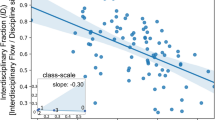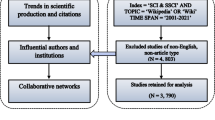Abstract
This paper develops an empirically validated theoretical model of a researcher’s publication goal to assess which standardisations and policies are more likely to achieve equity and efficiency in different disciplines. The main theoretical insight is that there is a trade-off between equity and efficiency, as well as between networking activity and knowledge-diffusion activity. The main empirical insight is that, in order to achieve equity and efficiency, the original version of the H index should be replaced by a version that is standardised per author and per year and calculated by excluding reciprocal citations and publications other than peer-reviewed articles.




Similar content being viewed by others
References
Castellani T, et al. Epistemic consequences of bibliometrics-based evaluation: insights from the scientific community. Soc Epistemol. 2016;30:398–419.
De Rijcke S, et al. Evaluation practices and effects of indicator use: a literature review. Res Eval. 2016;25:161–9.
Flatt JW, et al. Improving the measurement of scientific success by reporting a self-citation index. Publications. 2017;5(3):20.
Fong EA, Wilhite AW. Authorship and citation manipulation in academic research. PLoS ONE. 2017;12:e0187394.
Haley MR. On the inauspicious incentives of the scholar-level H-index: an economist’s take on collusive and coercive citation. Appl Econ Lett. 2017;24:85–9.
Harzing A-W, et al. hIa: an individual annual H-index to accommodate disciplinary and career length difference. Scientometrics. 2014;99:811–21.
Herteliu C, et al. Quantitative and qualitative analysis of editor behaviour through potentially coercive citations. Publications. 2017;5(2):15.
Muller R, De Rijcke S. Exploring the epistemic impacts of academic performance indicators in the life sciences. Res Eval. 2017;26:157–68.
Negahdary M, et al. The modified H-index of Scopus: a new way in fair scientometrics. Publ Res Q. 2018;34:430–55.
Parish AJ, et al. Dynamics of co-authorship and productivity across different fields of scientific research. PLoS ONE. 2018;13:e0189742.
Rath K, Wohlrabe K. Recent trends in co-authorship in economics: evidence from RePEc. Appl Econ Lett. 2016;23:897–902.
Zagonari F (2017) Scientific production and productivity in curriculum vitae characterisation: simple and nested H indices that support cross-disciplinary comparisons. http://amsacta.unibo.it/5601/1/WP1100.pdf.
Acknowledgements
I thank Alberto Zigoni and Jeroen Baas, Elsevier, for providing summary statistics for the Scopus dataset.
Author information
Authors and Affiliations
Corresponding author
Additional information
Publisher's Note
Springer Nature remains neutral with regard to jurisdictional claims in published maps and institutional affiliations.
Appendices
Appendix I: Sample Statistics
Appendix II: Validation Analysis
If the acceptable degree of the authorship effect is 5% rather than 10%, Fig. 1 becomes Fig. 5, whereas if the acceptable authorship effect is 20% rather than 10%, Fig. 1 becomes Fig. 6. Both these numerical solutions validate the model (i.e., the specified distance thresholds represented by the curved lines contain the vast majority of the data points).
Distance (curved line, % expressed as a decimal value) from equity (i.e., A* = 1) as a function of Cx (i.e., average per author citations for articles) and Cy (i.e., average per author citations for non-articles) if ec = 54.4. Blue points = citations per capita; red points = citations per capita per year. Table 1 provides the Cx and Cy values for each discipline (Color figure online)
Distance (curved lines, % expressed as a decimal value) from equity (i.e., A* = 1) as a function of Cx (i.e., average per author citations for articles) and Cy (i.e., average per author citations for non-articles) if ec = 12.85. Blue points = citations per capita; red points = citations per capita per year. Table 1 provides the Cx and Cy values for each discipline. Legend: ab agricultural and biological sciences, ah arts and humanities, bm biochemistry, genetics and molecular biology, ba business, management and accounting, ce chemical engineering, ch chemistry, co computer science, ds decision sciences, ep earth and planetary sciences, ef economics, econometrics and finance, en energy, e.g. engineering, ev environmental science, im immunology and microbiology, ma materials science, mt mathematics, me medicine, ne neuroscience, nu nursing, pp pharmacology, toxicology and pharmaceutics, pa physics and astronomy, ps psychology, so social sciences, ve veterinary, de dentistry, hp health professions (Color figure online)
Rights and permissions
About this article
Cite this article
Zagonari, F. Coping with the Inequity and Inefficiency of the H-Index: A Cross-Disciplinary Analytical Model. Pub Res Q 35, 285–300 (2019). https://doi.org/10.1007/s12109-018-09625-5
Published:
Issue Date:
DOI: https://doi.org/10.1007/s12109-018-09625-5






